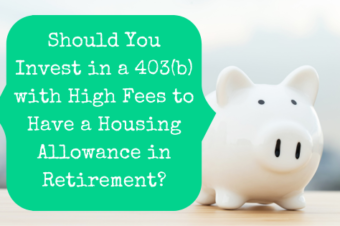
This post mentions some specific investments. They are only examples and not an endorsement of those investments.
Perhaps the most difficult, or at least most intimidating, thing about saving for retirement isn’t finding money to set aside, but rather choosing how to invest that money. After all, 1 in 5 Americans who aren’t invested in the stock market says it’s because they “don’t know enough.”
What Is A Target Date Fund?
Because of this, in 1994, a new kind of mutual fund was created: the target date fund (TDF). It is a kind of investment designed so that you can just put your money in and forget about it until it’s time to take your money out. You will recognize them because they have a future date in their name, like LifePath Index 2040 Fund or T Rowe Price Retirement 2040 Fund.
With a TDF, you get a complete portfolio in one investment. Your money is invested in a bunch of different stocks and bonds so that you won’t really feel it if one or two of them don’t work out. You don’t have to worry about being diversified amongst several different funds, it does that already for you.
Most people want safer investments as they near retirement. You don’t want to risk losing all your money right when you need it! A TDF automatically adjusts what it is invested in to get more conservative and less risky as the target retirement date approaches.
They also do automatic rebalancing. That means that every year they make adjustments to maintain the ratio of stocks to bonds based on the level of risk they want. TDFs do a lot of what professional money managers do, it’s just automated and based on a desired retirement date instead of your personal situation.
What To Look For In A Target Date Fund
If you’re investing in your 403(b) or a 401(k), your only choice will probably be the target retirement date and you won’t have TDFs from different companies to choose from. If, however, you’re investing in an IRA, you have numerous options. Even though they all have similar names, they are all unique. Whether you have few options or many, it is important to understand the following features:
Expenses
The industry average expense ratio for a TDF is 0.48%. That means for every $10,000 you have invested you will have to pay them $48 a year. While you shouldn’t just automatically pick the cheapest option, expenses do make a difference in your overall returns. For example, if your fund earns a 9% return, a 1% expense ratio will cost you 11% of your total returns (1 divided by 9 is .11 or 11%). If your 403(b) only offers TDFs with above-average expenses, you may want to request more affordable options.
Underlying Investments
A TDF is a mutual fund that invests in other mutual funds, not directly in stocks and bonds. For example, the Vanguard Target Retirement 2040 Fund is invested in the following Vanguard funds: Total Stock Market Index, Total International Stock Index, Total Bond Market II Index, and Total International Bond II Index.
Information on the underlying investments should be easy to find. Just look for a section titled Composition or Holdings or Portfolio. They will all be listed nicely for you and some even include the percentage of the TDF that is invested in each underlying fund.
Glide Path
This is just a cool name for when the fund hits its most conservative point. Some funds are the most conservative right on the target retirement date. Others wait a while after retirement to reach that point.
When reviewing a TDF, there probably won’t be a line that simply says “glide path.” It will be in the description or the fine print and read something like:
In the seven years following retirement, the asset mix will continue to dial down stock exposure, until it’s only 30 percent. (Vanguard)
Over time, the allocation to asset classes will change according to a predetermined “glide path” that adjusts the percentage of fixed income securities and the percentage of equity securities to become more conservative each year until approximately 15 years after the target date. (Guidestone)
The glide path is important because it tells you when the TDF will be focused more on preserving your money than on earning more. If you want to be more conservative, you can choose a date earlier than you plan to retire. If you want to be more aggressive, you can choose a date after you expect to retire.
Is A Target Date Fund Right For You?
Do you consider yourself a do-it-yourselfer? Do you enjoy learning about investments? Or does the mere thought make you want to run away screaming?
If you’re the kind of person who likes to DIY and learn things for yourself, then a TDF might not be the best option for you. You’ll probably have more fun and may even get better returns choosing your own mutual funds.
But if investing scares you or bores you, a TDF might be just the thing for you. Or, if you haven’t even started investing yet because it’s just too overwhelming, then go get yourself a TDF. Target date funds are not perfect, but they’re a whole lot better than doing nothing. Investing has never been easier than it is right now with TDFs. Take advantage of it and get a jump start on your future. You won’t regret it.




3 Responses
Rick Huff
June 5, 2023100% Right On.
Our firm (retired from) uses them with 529 plans.
As you said, if you don’t have enough for an investment manager, a TDF is extremely appropriate; just get a low cost fund.
Amy
June 8, 2023Thanks for the support, Rick!